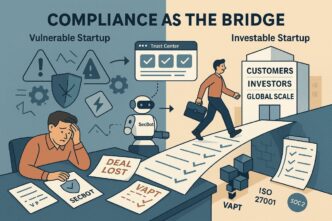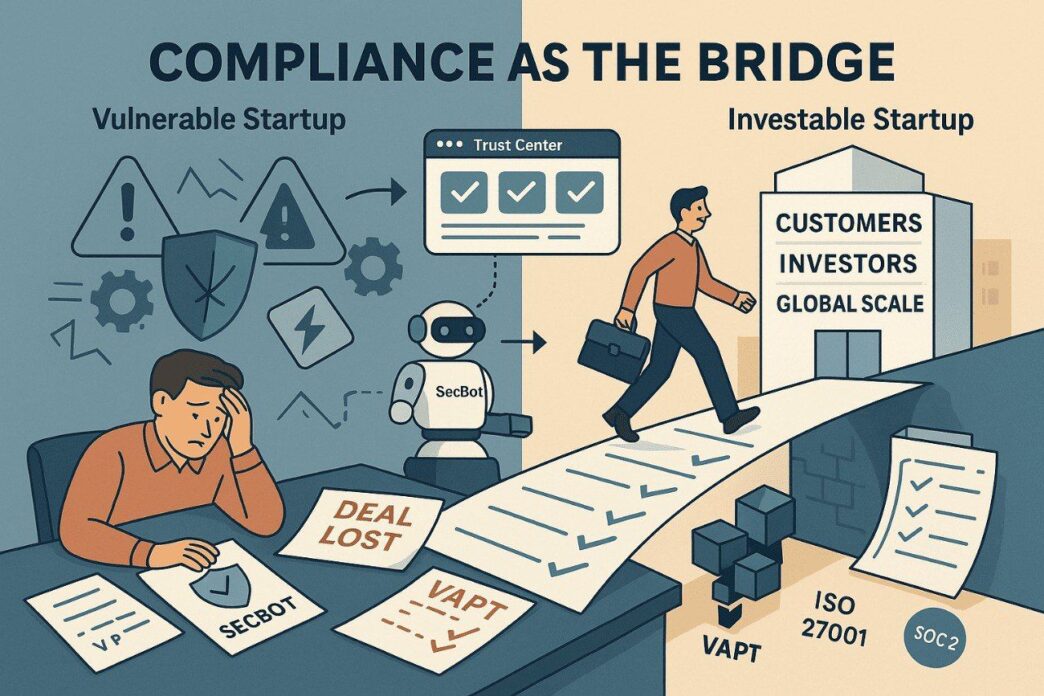“We loved the product, but our security team couldn’t get comfortable.”
That was the line that ended what should’ve been a flagship customer deal. The startup had nailed the demo, pricing was agreed, and timelines were aligned. But when the enterprise buyer’s compliance questionnaire landed, the wheels came off. The team couldn’t produce security policies, had no recent penetration test, and hadn’t mapped their data flows. Within days, the deal evaporated.
For many SaaS startups, this is a wake-up call. In a world where software is moving faster than ever, compliance has emerged as the gatekeeper of trust, and, increasingly, the engine of growth.
Compliance Isn’t Just a Risk Thing, It’s a Revenue Thing
There’s been a quiet shift. Where compliance once meant heavy binders, auditors, and reactive defence, today it unlocks sales, accelerates procurement, and signals maturity to investors.
Frameworks like ISO 27001, SOC 2, and GDPR are no longer just for post-Series C companies. Seed-stage and Series A startups are now expected to show traction on these fronts, especially if they’re targeting mid-market or enterprise clients.
This shift is driven by:
- Increasing buyer scrutiny post high-profile breaches
- Investor demand for operational maturity
- Regulatory expectations around data protection
As AI accelerates code generation and workflow automation, especially through agentic systems, building a world-class product from a garage or coworking space is more feasible than ever. But this speed also exposes early-stage startups to deeper vulnerabilities. The abstraction of core infrastructure shifts operational risk into third-party dependencies, libraries, and services. These embedded components create a complex digital supply chain where threats are harder to identify, monitor, or mitigate.
Governments and policymakers have taken notice. NIS2, DORA, the EU AI Act, and the NIST AI Risk Management Framework (AI RMF) have joined a growing list of acronyms pressuring even young, fast-growing companies to align with mature security practices. It’s no longer just ISO and SOC2 in the conversation. It’s AI safety, algorithmic accountability, and operational resilience.
As Goldman Sachs stated in their open letter to suppliers:
“Security maturity is now a business-critical expectation.”
Startups that want to sell to the enterprise or scale across jurisdictions cannot afford to ignore this shift.
Startups Face a Unique Challenge
Most early-stage companies have no CISO, no GRC lead, and barely a sliver of engineering time to spare. Compliance falls between the cracks, surfacing only when the RFP lands or a potential partner asks about encryption protocols.
What follows is often a scramble:
- Developers fielding questionnaires they’re not trained to answer
- Founders promising “we’ll get that in place” on sales calls
- Security policies cobbled together from internet templates
It’s not negligence. It’s just that the playbook for early-stage compliance hasn’t been widely shared, until now.
Start With Security Hygiene That Scales
The good news? You don’t need a full team to build a solid foundation.
Smart teams start with these five practices:
- Role-based access control (RBAC) and single sign-on (SSO)
- Audit logging of infrastructure, authentication, and deployments
- Infrastructure-as-code (IaC) scanning with tools like tfsec or Checkov
- Software Bill of Materials (SBOM) generation for third-party components
- Secrets management using encrypted storage and environment-based rotation
A lean product team implementing these practices not only reduces risk, it buys back engineering time and builds readiness for later frameworks.
Proving Trust is the Real Advantage
Security posture without visibility is like a seatbelt no one can see. Buyers don’t just want to hear that you’re secure, they want to see how.
That’s why startups are increasingly creating lightweight, modern Trust Centres. These are living artefacts that include:
- Data handling and retention policies
- Incident response plans
- System uptime and past issues
- Audit status and certifications in progress
Trust Centres turn your security maturity into a marketing asset. They answer questions before they’re asked, and win confidence before friction appears.
Picking the Right Stack to Automate the Hard Parts
At some point, spreadsheets and DIY controls hit a wall. That’s where compliance automation platforms come in, streamlining operations, improving audit readiness, and reducing engineering overhead.
These platforms typically fall into three generations, each aligned with a different stage of maturity and need:
- Gen 1 – Audit Preparation Tools: Built to package evidence, manage vendor risks, and maintain templated policy libraries. Favoured by compliance and finance teams, their strength lies in enabling fast certification, but they often require manual inputs and operate in silos.
- Gen 2 – Framework Orchestration Platforms: Focused on multi-standard compliance (e.g., SOC 2, ISO 27001, GDPR), these tools offer centralised control mapping, asset inventory, and gap tracking. They work well for companies scaling across geographies, but typically operate as dashboards rather than active systems.
- Gen 3 – Developer-Integrated Systems with AI Resolution: Designed for engineering-first teams, these platforms embed into CI/CD pipelines, detect drift or misconfiguration in real time, and trigger just-in-time remediation. They form a living control plane, closing the loop between security, auditability, and speed. This also reduces your Mean Time to Remediation (MTTR), significantly.
Each approach offers value. But the smart move is mapping your current challenge to the right generation; don’t follow the crowd; align your choice with your team’s workflows, risk profile, and growth velocity.
The Real Cost of Delay
Compliance debt compounds silently:
- Deals are delayed by weeks due to missing documentation
- Engineers lose valuable build time to manual evidence gathering
- Customer churn increases when risk is sensed but not addressed
And should a breach occur, even a minor one, reputation and revenue take a disproportionate hit.
A Founder’s Role Isn’t to Be the CISO, It’s to Set the Tone
You don’t need to master ISO clauses to lead on security. But as a founder, you do shape the culture:
- Prioritise posture in product planning
- Fund automation before headcount
- Frame security in investor decks as enablement, not overhead
Your credibility with buyers and investors increases when you show that security is a strategic pillar, not an afterthought.
Beyond Revenue: Compliance as a Signal for Global Scale
Startups that take compliance seriously from day one don’t just reduce risk. They build credibility where it matters most.
Compliance signals operational maturity. It shows investors the business is built to scale. It gives enterprise and public-sector buyers the confidence to move forward.
It also smooths due diligence. Cross-border deals close faster. Regulated markets become accessible.
In a global market, trust is not a bonus; it’s a lever for growth. And compliance is how you earn it.
From Vulnerable to Investable
For SaaS startups, compliance isn’t a late-stage checkbox. It’s a strategic edge.
Teams that prioritise it ship faster, close bigger deals, and expand into new markets without friction. But the real value becomes evident when things go wrong.
Frameworks like ISO 27001, PCI-DSS, or NIS2 aren’t just about controls, they’re about containment. When a breach hits somewhere in your supply chain, compliance helps isolate the blast, sever the kill chain, and limit downstream damage. That’s exactly why enterprises and government buyers insist on it.
Compliance is proof that your startup won’t become someone else’s weakest link. And in an ecosystem built on trust, that proof is everything.
So if you’re still wondering when to get serious about security, here’s your answer: before the next opportunity demands it, and before the next breach tests it.













